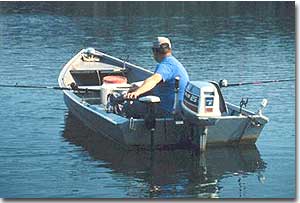Live Bait Time is Here Again
Live Bait Time is Here Again
By Bill Vanderford
At this time each year, both predators and baitfish tend to suspend in open water and can be caught using several methods. To assure guaranteed success, however, live bait becomes the best choice for bass and stripers in these open water areas.
 The key to being productive is to locate a place that has plenty of baitfish in sizable schools. Once these forage fish have been found, one should attempt to ascertain the predominant size of the baitfish in that particular area.
The key to being productive is to locate a place that has plenty of baitfish in sizable schools. Once these forage fish have been found, one should attempt to ascertain the predominant size of the baitfish in that particular area.
Experience teaches that in cold weather, the type of minnow used is not always extremely important. In the past, it was generally thought that only natural threadfin or gizzard shad would work, but catching these minnows usually requires plenty of work throwing a cast net. For guides, this exercise with the cast net is just part of the days work, but for the average weekend angler, another solution is possible. Just take a trip to the local bait store and buy a couple dozen, commercially-raised, emerald shiners in the correct size. Unlike shad, these "store bought" minnows can be dumped into the lake water in a bass boat livewell and will survive for weeks during cooler weather in any clean water and without chemical help.
The equipment used to catch big largemouth, spotted bass, white bass, or stripers does not have to be exact either. In fact, anything from spinning tackle with 8 pound/test line to the heavier baitcasting outfits has proven to be adequate. My preference for everything except stripers is a 6 to 8 foot, medium action, soft-tipped rod, and spinning reel with the drag set loose. The definition of a medium action rod may vary from one manufacturer to another, but basically what is needed is a rod with a soft tip and enough backbone to set the hook and fight a big bass properly. The soft tip will result in a higher percentage of hooked fish with live bait, especially if the drag is "backed-off" allowing an easy pull when the bass takes the bait. Also, before the hook can be set, the drag should be tightened. The advantage of the spinning outfit, however, is its capacity for using smaller diameter line, which allows the use of lighter sinkers to hold the bait at the proper depth.
Rod holders are a necessary item when fishing shiners for any of the bass species. Easily detachable rod holders with tiny flat bases can be mounted permanently to locker lids or into the fiberglass. Each holder is incorporated into a threaded shaft that screws in or out of the base plate and is held tight with a wing-nut.
The actual rig used when fishing a live shiner on a down-line is about the same as a standard Carolina rig. A 1/2 ounce egg or bullet sinker is the first item to be placed on the line; this is followed by a plastic bead with a barrel swivel tied to the end of the line. About two feet of leader material is usually attached to the other side of the barrel swivel, and a stout #1 short-shank hook is tied to the end of that leader.
Hook emerald shiners by pushing the point of the hook between one of the small creases on the underside of the jaw and up through the meaty part of their upper lip. This seems to hold them on the hook very well, and they tend to stay alive for a long period of time.
The baited rigs are then dropped to different depths between 15 and 50 feet. The only exceptions to this are when my Lowrance 2000 graph recorder shows huge concentrations of fish at a particular depth or when feeding fish are seen periodically driving shad to the surface. When this occurs, I usually bring one of the down-lines up, cut the rig off, tie a hook directly to the end of the unweighted line, and free-line the shiner approximately 50 feet behind the boat.
While these rigs are down at their respective depths, the electric trolling motor is used to ease the boat along a path where fish have been seen visually or on sonar. Most of these areas are adjacent to defined creek channels.
A cold front without a lot of rain only tends to bunch the bass into a smaller area and usually at a certain depth. Though this may slow down their aggressive nature, when these bass are located, it often makes them easier to catch using this slow method with live shiners.
Though these methods don't include lots of new gimmicks or name brand items for fishermen to rush out and buy, the results are usually bigger fish. Successful fishing is never quite as complicated or exact as some would lead you to believe, so keep it simple and make the most out of each trip!
Bill Vanderford has won numerous awards for his writing and photography, and has been inducted into the Freshwater Fishing Hall of Fame as a Legendary Guide. He can be reached at 770-962-1241, [email protected], or at his web site: www.fishinglanier.com
|
